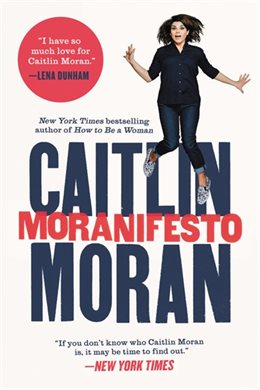 Caitlin Moran is a prize-winning columnist for The Times of London where she has been publishing witty, pithy, and sometimes acerbic pieces about film, pop culture, politics and whatever random subject strikes her interest for the last 24 years. Unlike most regular columnists, she moves back and forth between light entertainment pieces and hard hitting op-ed material deftly. The closest widely read American women writers to her style might be Maureen Dowd and Gail Collins, though neither of them makes the kinds of forays into popular culture that Moran does.
Caitlin Moran is a prize-winning columnist for The Times of London where she has been publishing witty, pithy, and sometimes acerbic pieces about film, pop culture, politics and whatever random subject strikes her interest for the last 24 years. Unlike most regular columnists, she moves back and forth between light entertainment pieces and hard hitting op-ed material deftly. The closest widely read American women writers to her style might be Maureen Dowd and Gail Collins, though neither of them makes the kinds of forays into popular culture that Moran does.
In addition to her frequent short newspaper pieces, Moran has published a novel titled How to Build a Girl (2014) which followed her first collection titled How to Be a Woman (2011). Now, another collection of columns has appeared titled Moranifesto (2016) and it lives up to the implications of its title. Consisting of 66 mostly short essays that have a “take no prisoners” approach, the collection is full of some pretty rough shots. Titles such as Why We Cheered in the Streets When Margaret Thatcher Died or Women Keep Fucking Things Up capture both her iconoclastic bent as well as, in the latter case, a biting sense of irony.
Of course, Moran writes about menstruation
For the purposes of the Menstruation Matters blog, it is worth noting an item in Moranifesto titled A Woman’s Monthly Faultiness. In less than three taut pages Caitlin Moran thoroughly skewers the taboos and shame conditioning that still make menstruation mentions off limits across the entire public and social landscape. The essay opens with the kind of faux apology that is common when one ventures into forbidden territory:
Gentle, sweet reader of The Times, this week it is my sad duty to inform you that this column is to be on the topic of an immense beastliness–one I can still scarcely bring myself to mention, even now, after the application of a patent draft for fortifying the nerves. And it is–and Lord forgive me!–this: the circumstance of a woman’s monthly faultiness.
The piece races along from there with the kind of heightened rhetoric derived from a Victorian era that in other realms of discourse has been long abandoned. And she has a lot fun inventing new euphemisms while she’s at it, my favorites being “Paul McCartney’s Magic Fairy Potion” for first period and “Great British Bake Off Christmas Special” for the onset of a new one.
The fact that this and other similarly rambunctious items managed to get published in one of the most “respectable” papers in Britain invites one to ask if anything nearly as edgy would find space in a similar American outlet. I tend to doubt it.
Menstrual mentions in movies
There is, however, one area where Moran either simply gets it wrong or else she is being hyperbolic to make a point. At the end of the essay she claims that the only feature film to depict a menstrual moment in the past twenty-seven years was Carrie and that it amounted to “one huge, horrific celluloid visitation to Cafe Rouge.” Now there’s no arguing that Carrie is, in menstrual terms, a bloody disaster. But, there have been many more–both positive and negative–representations since and the steadily increasing depictions deserve to be acknowledged.
Caitlin Moran is hereby invited to look at a few of our previous postings about menses and movies such as the post about the 2009 film starring Rachel Weisz, Agora, or the bio pic about T.S. Eliot titled Tom & Viv. Even more robust are the many television programs that have dealt in detail with menstrual encounters as in South Park, Degrassi, and my favorite, Curb Your Enthusiasm. And Menstruation Matters introduced a whole month’s worth of posts exploring menstrual mentions in books, TV, film and comedy with this post in December, 2015.
The cultural menstrual ecology is a rich and varied environment that warrants ongoing examination. I’ve heard from several people there is a great dinner table scene all about menstruation in the new Annette Bening film, 20th Century Women.
David Linton is an Emeritus Professor at Marymount Manhattan College. He is also Editor of the SMCR Newsletter and a member of the Menstruation Matters editorial board. His research focus is on media representations of the menstrual cycle as well as how women and men relate to one another around the presence of menstruation.

